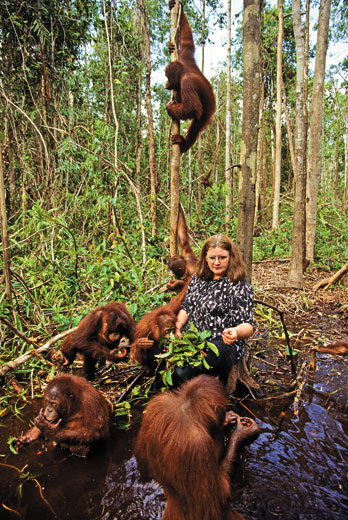The Anthropologist Who Has Spent 50 Years Protecting--and Learning From--Orangutans [View all]
Biruté Mary Galdikas has quietly fought on the frontlines of some of conservation’s biggest battles.
BY GEMMA TARLACH
MARCH 24, 2022
THE CIGARETTE BUTTS AND PLASTIC wrappers were the first warning signs. The trash, found deep in the rain forest of Southern Borneo’s Tanjung Puting National Park in the late 1990s, was worrisome evidence that a new batch of poachers was on the prowl. Over several decades, the region had been hit by illegal loggers and rampant, unregulated fishing of the endangered Asian arowana, or dragon fish. Slash-and-burn clearing for palm oil plantations and open-pit gold mining continued to bite into the borders of the protected land. Now hunters were targeting orangutans, either to capture them for animal trafficking or simply to kill the primates as an “agricultural pest.”
Biruté Mary Galdikas and her team were ready for them.
As they had when facing past threats, Galdikas and rangers from Orangutan Foundation International (OFI), which she cofounded in 1986, sprang into action, lobbying the government, raising alarms, and forming partnerships with regional police, who were reluctant to venture into the wilderness on their own. Galdikas even led some of the patrols, sometimes sneaking up on poachers’ makeshift shelters in a Zodiac boat powered by a quiet electric motor. Despite some success and continued vigilance, the threat of poaching continues today—as does her resolve. Since her first venture into the field more than 50 years ago, Galdikas has never stopped her work, or her advocacy for the animals and people who call the rain forests home.
In the early 1970s, the media dubbed Galdikas one of “Leakey’s Angels,” a reference to the trio of young women who had secured funding for primate research from famed anthropologist Louis Leakey. Also known as the “Trimates,” the group included Jane Goodall, who went on to fame for her observations of chimpanzees before trading fieldwork for high-profile conservation outreach and environmental activism in the 1980s. The other member of the trio, Dian Fossey, continued her research on mountain gorillas until her murder in 1985. Both women are household names today, but it is the lesser-known Galdikas who may have the greatest impact on primate science and community-forward conservation. Born in Germany to Lithuanian parents, raised in Canada, and educated there and in the United States, Galdikas would find her true home, and her calling, in Borneo.

A female orangutan and her infant move through the forest of Tanjung Puting National Park. RAIYANIM, CC BY-SA 4.0/WIKIMEDIA
More:
https://www.atlasobscura.com/articles/galdikas-orangutan-borneo










